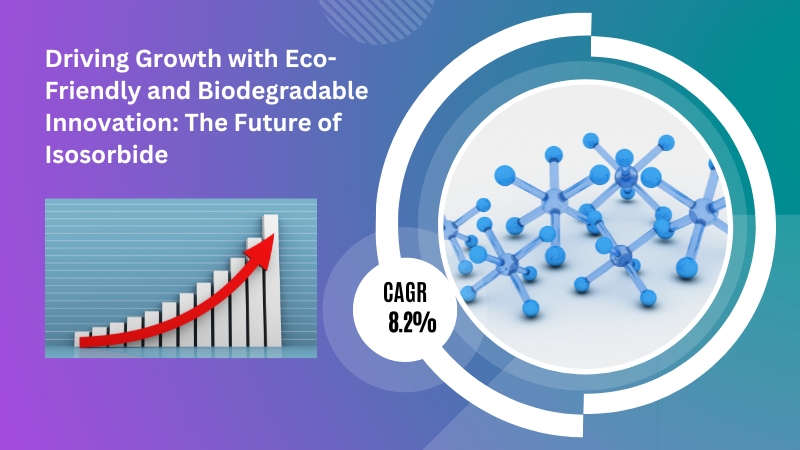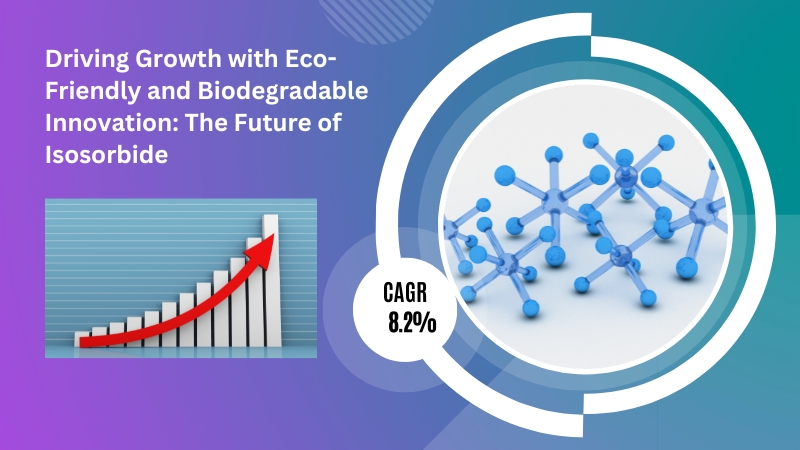
Wilmington, Delaware, Transparency Market Research, Inc. , Dec. 10, 2024 (GLOBE NEWSWIRE) — As per the report published by Transparency Market Research, the Isosorbide market (イソソルビド市場) size was worth US$ 27.9 Mn in 2023 and is expected to reach US$ 65.7 Mn by the year 2034 at a CAGR of 8.2 % between 2024 and 2034.
Isosorbide is a versatile organic compound derived from renewable resources such as sorbitol, which is sourced from starch-rich crops like corn, wheat, and potatoes. It is a bicyclic diol characterized by its eco-friendly production process and wide-ranging industrial applications. As a bio-based product, isosorbide plays a significant role in promoting sustainability in various sectors, particularly in plastics, pharmaceuticals, and coatings.
Isosorbide exhibits high thermal stability, excellent chemical resistance, and biodegradability, making it an attractive alternative to petroleum-based chemicals. Its compatibility with other polymers and compounds enables it to enhance the mechanical and optical properties of materials. Additionally, its non-toxic nature supports its use in environmentally friendly applications.
For More Details, Request for a Sample of this Research Report: https://www.transparencymarketresearch.com/sample/sample.php?flag=S&rep_id=1030

Leading Players Operating in Isosorbide Industry
Cargill Inc., Roquette Frères, Archer Daniels Midland Company, Novaphene, Mitsubishi Chemical Group, Shri Rajaram Chemicals & Engineering, JP Laboratories, and Endo Inc. are some of the leading key players operating in the industry.
Increasing Demand for Bio-Polymers in Diverse Applications
The growing adoption of bio-polymers such as polyethylene isosorbide terephthalate (PEIT) in packaging, automotive components, and consumer goods is significantly boosting the demand for isosorbide. These bio-polymers are recognized for their enhanced properties, including superior transparency, rigidity, and durability, making them suitable for a wide range of applications. In packaging, the focus on sustainable materials is driving the use of bio-polymers, while in the automotive industry, lightweight yet durable components are essential for improving fuel efficiency. Isosorbide’s role as a core ingredient in these polymers underscores its increasing importance in meeting evolving industrial and consumer demands.
Technological Innovations Enhancing Production Efficiency
Technological progress in renewable chemistry has significantly improved the production efficiency and cost-effectiveness of isosorbide. Innovations in manufacturing processes, such as catalytic and enzymatic conversion of sorbitol, are enabling higher yields and better product quality. These advancements have expanded the scalability of isosorbide production, making it more accessible for a broader range of applications. Additionally, ongoing research and development efforts are discovering new uses for isosorbide, from advanced materials to specialized coatings, further driving market growth and enhancing its appeal across multiple industries.
Expanding Pharmaceutical Applications and Regulatory Support
The pharmaceutical industry is a growing consumer of isosorbide, particularly for cardiovascular treatments. As a vasodilator, isosorbide is effective in managing conditions such as angina and heart failure, making it an essential component in medications targeting cardiovascular diseases. Additionally, governments worldwide are encouraging the adoption of bio-based and renewable materials through favorable policies, subsidies, and environmental regulations. This regulatory support not only promotes sustainable industrial practices but also provides significant growth opportunities for isosorbide in industries like plastics, coatings, and personal care.
Request a Custom Report – https://www.transparencymarketresearch.com/sample/sample.php?flag=S&rep_id=1030
Growing Adoption in Key Industries
The increasing use of bio-polymers such as polyethylene isosorbide terephthalate (PEIT) in packaging, automotive components, and consumer goods is significantly boosting the demand for isosorbide. These bio-polymers are valued for their enhanced properties, including superior transparency, rigidity, and durability, making them ideal for various applications. In packaging, the push for sustainable materials drives the use of bio-polymers, while in the automotive industry, lightweight yet durable components are crucial for improving fuel efficiency. Isosorbide’s role as a core ingredient in these materials highlights its growing importance in meeting industrial and consumer demands.
Advancements in Production Technologies
Technological advancements in renewable chemistry have significantly improved the production efficiency and cost-effectiveness of isosorbide. Innovations such as catalytic and enzymatic conversion of sorbitol have led to higher yields and improved product quality. These advancements have also expanded the scalability of isosorbide production, making it more accessible for diverse applications. Ongoing research and development are uncovering new uses for isosorbide, from advanced materials to specialized coatings, further driving market growth.
Expanding Applications in Pharmaceuticals
The pharmaceutical industry represents a growing market for isosorbide, particularly in cardiovascular treatments. As a vasodilator, isosorbide is effective in managing conditions like angina and heart failure, making it a critical component in medications targeting cardiovascular diseases. With the rising prevalence of these health issues globally, the demand for isosorbide in pharmaceuticals is expected to increase steadily. Its non-toxic nature and compatibility with other drug compounds enhance its utility, enabling the creation of safe and effective medical solutions.
Regulatory Support for Sustainability
Governments worldwide are promoting the use of bio-based and renewable materials through favorable policies, subsidies, and environmental regulations. These measures aim to encourage sustainable industrial practices and reduce reliance on fossil fuels. For isosorbide, such initiatives present significant growth opportunities, incentivizing manufacturers to adopt eco-friendly raw materials.
Driving Market Expansion
Regulatory frameworks focused on reducing carbon emissions and limiting harmful chemicals in industries such as plastics and coatings are accelerating the transition to isosorbide-based solutions. This regulatory support fosters a favorable environment for market expansion, ensuring the continued growth of isosorbide adoption across sectors.
Versatility and Sustainability
Isosorbide plays a critical role in advancing sustainability while enabling innovation across industries like plastics, pharmaceuticals, coatings, and personal care. Its versatility, eco-friendly properties, and alignment with global sustainability goals ensure it remains a key driver of bio-based innovation and industrial growth.
Isosorbide Market Report Scope:
| Report Coverage | Details |
| Forecast Period | 2024-2034 |
| Base Year | 2020-2022 |
| Size in 2023 | US$ 27.9 Mn |
| Forecast (Value) in 2034 | US$ 65.7 Mn |
| Growth Rate (CAGR) | 8.2% |
| No. of Pages | 261 Pages |
| Segments covered | By Grade, By Application, By End-use. |
Isosorbide Market Regional Insights
• Asia Pacific estimated to Record Rapid Growth during Forecast Period
The Asia Pacific region is experiencing a significant growth in the adoption of bio-based materials, driven by the rising demand for sustainable packaging and eco-friendly solutions. Isosorbide plays a crucial role in bio-polymer manufacturing, particularly in the production of bio-based polyethylene terephthalate (PET) and polyethylene isosorbide terephthalate (PEIT), which are used in packaging, textiles, and automotive industries.
The increasing preference for renewable materials, driven by both – consumer demand for greener products and government regulations supporting sustainability, has elevated the demand for isosorbide in bio-polymer applications. As industries such as packaging and textiles evolve, the need for bio-based, recyclable, and high-performance materials is expanding rapidly, leading to a surge in isosorbide use across these sectors.
In the Asia Pacific region, governments are actively promoting green and sustainable initiatives to combat environmental challenges, such as pollution and plastic waste. Many countries have introduced regulations and incentives that encourage the use of bio-based materials, including isosorbide, in industries like packaging, automotive, and construction. For example, China, India, and Japan are investing in green chemistry and are looking to reduce dependency on petrochemical-derived products. These policies are boosting the demand for bio-based alternatives like isosorbide, driving its adoption in both the polymer and chemical industries.
Recent Developments in Isosorbide Market
In January 2024, Roquette announced that it had received the International Sustainability and Carbon Certification (ISCC) PLUS for its POLYSORB® isosorbide, along with the product grades POLYSORB® PSA, POLYSORB® LP, and POLYSORB® PA. This certification reinforces Roquette’s commitment to sustainability throughout the value chain for its plant-based ingredient ‘POLYSORB® isosorbide’, which has been available in the market for over a decade. POLYSORB® isosorbide is a groundbreaking, 100% plant-based monomer, which provides a versatile and environmentally-friendly alternative to traditional materials. It enhances the performance of materials while reducing their environmental impact, making it an ideal choice for applications in packaging, plasticizers, polycarbonates, polyurethanes, and paints and coatings.
Buy This Premium Research Report Now to Get Detailed Analysis: https://www.transparencymarketresearch.com/checkout.php?rep_id=1030<ype=S
Isosorbide Market Segmentation
- Grade
- Technical Grade
- Pharmaceutical Grade
- Food Grade
- Application
- Polyethylene Isosorbide Terephthalate (PEIT)
- Polycarbonate
- Polyurethane
- Polyester Polyisosorbide
- Isosorbide Diesters
- Others
- End-use
- Resins & Polymers
- Additives
- Others
More Trending Reports by Transparency Market Research –
- Plastic-eating Bacteria Market (プラスチックを食べる細菌市場) – The global plastic-eating bacteria market is anticipated to advance at a CAGR of 15.1% during the forecast period from 2022 to 2031
- Carbotanium Market (Marché du Carbotanium) – The global carbotanium market is anticipated to grow at a CAGR of 16.0% during the forecast period from 2022 to 2031.
- Finishing Lines Market (Marché Des Lignes de Finition)- The global market is estimated to attain a valuation of US$ 11.0 Bn by the end of 2031, The report notes that the market is prognosticated to expand at a CAGR of 4.5% during the forecast period, 2022-2031.
- Hyperelastic Material Market (Mercado de Materiales Hiperelásticos) – The research report finds that the market for hyperelastic material is expected to grow at a CAGR of 4.89% during the forecast period, from 2022 to 2031.
About Transparency Market Research
Transparency Market Research, a global market research company registered at Wilmington, Delaware, United States, provides custom research and consulting services. Our exclusive blend of quantitative forecasting and trends analysis provides forward-looking insights for thousands of decision makers. Our experienced team of Analysts, Researchers, and Consultants use proprietary data sources and various tools & techniques to gather and analyses information.
Our data repository is continuously updated and revised by a team of research experts, so that it always reflects the latest trends and information. With a broad research and analysis capability, Transparency Market Research employs rigorous primary and secondary research techniques in developing distinctive data sets and research material for business reports.
Contact:
Transparency Market Research Inc.
CORPORATE HEADQUARTER DOWNTOWN,
1000 N. West Street,
Suite 1200, Wilmington, Delaware 19801 USA
Tel: +1-518-618-1030
USA – Canada Toll Free: 866-552-3453
Website: https://www.transparencymarketresearch.com
Email: sales@transparencymarketresearch.com
Follow Us: LinkedIn| Twitter| Blog | YouTube

© 2024 Benzinga.com. Benzinga does not provide investment advice. All rights reserved.




